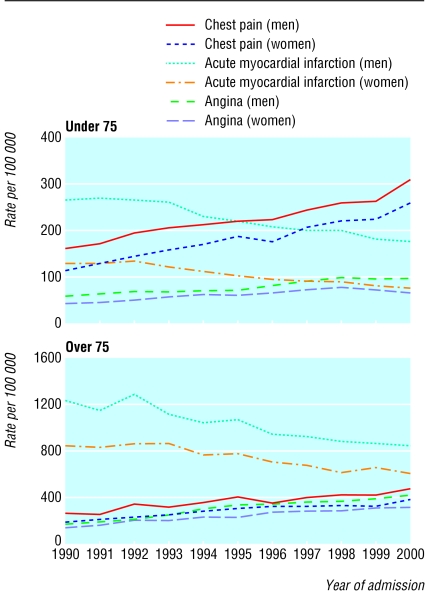Although hospital discharge rates for acute myocardial infarction are falling,1-4 no contemporary studies compare temporal trends in these rates for angina and other types of chest pain. We examined recent trends in population discharge rates for myocardial infarction, angina, and chest pain (“suspected acute coronary syndromes”) between 1990 and 2000.
Participants, methods, and results
We got data from the Scottish morbidity record for Scottish residents aged at least 18 years with a “first” emergency hospitalisation for myocardial infarction (codes ICD-9 (international classification of diseases, ninth revision) 410, ICD-10 I21 or I22), angina (ICD-9 411 or 413; ICD-10 I20 or I24.9) or “other chest pain” (ICD-9 786.5; ICD-10 R07), between 1990 and 2000.5 We analysed discharges coded only in the principal position. A “first” hospitalisation was one with no discharge diagnosis of coronary heart disease or chest pain in the previous 10 years.
We calculated rates using annual official age and sex specific population estimates for 1990-2000 and tested the significance of trends in discharge rates with linear regression.
We found 225 512 first hospitalisations for suspected acute coronary syndrome with a discharge diagnosis of myocardial infarction in 96 026 (43%), angina in 37 403 (17%), and other chest pain in 92 083 (41%). Patients with angina were on average 11 years older and those with myocardial infarction 13 years older than patients with chest pain (both P < 0.001).
The population discharge rate for myocardial infarction fell by a third, from 260 to 173 per 100 000 between 1990 and 2000 (regression coefficient (average change per year in population hospitalisation rate) -9.9; 95% confidence interval -11.5 to -8.2). Conversely, the rate for angina increased by 79%, from 59 to 105 per 100 000 (5.2; 4.3 to 6.1). The discharge rate for other chest pain increased by 110%, from 114 to 296 per 100 000 (coefficient 13.6; 11.6 to 15.5). The rate for myocardial infarction or angina decreased by 12%, from 319 to 278 per 100 000 (-4.7; -6.6 to -2.7), though that for any suspected acute coronary syndrome increased by a quarter, from 460 to 574 per 100 000 (8.9; 6.0 to 11.8).
The greatest change, across all diagnostic subgroups, was in elderly people (figure). The decline in myocardial infarction was much greater in men than in women in young and older age groups. The increase in angina was slightly greater in men than in women in both age groups. For chest pain, the increases were comparable in men and women in both age groups.
Figure 1.
Population discharge rates per 100 000 per year for acute myocardial infarction, angina, and chest pain in Scotland, 1990-2000 by age group
Comment
The fall in hospitalisation rates for myocardial infarction is consistent with reports from other countries but contrasts with the rise in rates for angina and chest pain.1-4 The Minnesota heart survey, the only other study to show a rise in discharge rates for angina, reported a 56% increase in men (30% in women) during 1985-1995 (with a 20% decline for myocardial infarction in men and women).4 We found no similar reports of an increase in chest pain discharges.
Possible reasons for this apparent shift are increased survivorship from previous acute coronary events (unlikely given that we looked only at first admissions); a change in the clinical course of coronary heart disease (overall decline and shift from presentation with infarction to angina—for example, because of wider use of aspirin); better diagnostic exclusion of infarction; or “threshold” changes for both admission and diagnosis over the period of study.
The increase in hospitalisations for angina and chest pain has enormous implications for resources, finances, and services—for example, expansion of coronary intervention for increasing angina and development of observation units for chest pain to avoid admission for non-coronary chest pain.
What is already known on this topic?
Incidence of acute myocardial infarction has declined in recent years
What this study adds
Between 1990 and 2000, population hospitalisation rates for angina increased by 79%, for chest pain by 110% (acute myocardial infarction declined by 33%), and for any suspected acute coronary syndrome (myocardial infarction, angina, or chest pain) by 25%
These increases have important financial and service implications
This article was posted on bmj.com on 21 May 2004: http://bmj.com/cgi/doi/10.1136/bmj.38111.650741.F7
Contributors: NM, KM, SC, and JMcM designed the study. NM coordinated the study, analysed the data, and led the writing team. NM and KM contributed to the study design, data analysis, and report drafting. SS, JP, JC, AR, and JB helped analyse and interpret the data and draft the report. SF contributed to the study design and extracted the data. All investigators contributed to the final report. JM, KM, and NM are guarantors.
Funding: NM is funded by the British Heart Foundation, SS is supported by the National Health and Medical Research Council of Australia and the National Heart Foundation of Australia.
Competing interests: None declared.
Ethical approval: Not needed.
References
- 1.Rosen M, Alfredsson L, Hammar N, Kahan T, Spetz CL, Ysberg AS. Attack rate, mortality and case fatality for acute myocardial infarction in Sweden during 1987-95: results from the national AMI register in Sweden. J Intern Med 2000;248: 159-64. [DOI] [PubMed] [Google Scholar]
- 2.Marques-Vidal P, Ruidavets JB, Cambou JP, Ferrieres J. Incidence, recurrence, and case fatality rates for myocardial infarction in southwestern France, 1985 to 1993. Heart 2000;84: 171-5. [DOI] [PMC free article] [PubMed] [Google Scholar]
- 3.Goldberg RJ, Yarzebski J, Lessard D, Gore JM. A two-decades (1975 to1995) long experience in the incidence, in-hospital and long-term case-fatality rates of acute myocardial infarction: a community-wide perspective. J Am Coll Cardiol 1999;33: 1533-9. [DOI] [PubMed] [Google Scholar]
- 4.McGovern PG, Jacobs DR Jr, Shahar E, Arnett DK, Folsom AR, Blackburn H, et al. Trends in acute coronary heart disease mortality, morbidity, and medical care from 1985 through 1997: the Minnesota heart survey. Circulation 2001;104: 19-24. [DOI] [PubMed] [Google Scholar]
- 5.Kendrick S, Clarke J. The Scottish record linkage system. Health Bull (Edinb) 1993;51: 72-9. [PubMed] [Google Scholar]



